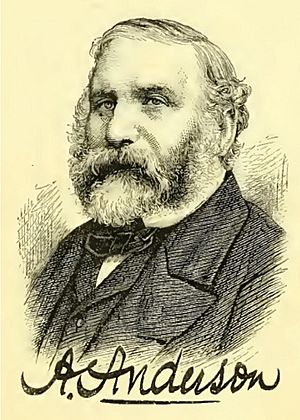Alexander Anderson (botanist) facts for kids
Quick facts for kids
Alexander Anderson
|
|
|---|---|
 |
|
| Born | 1748 |
| Died | 1811 |
| Alma mater | University of Edinburgh |
| Occupation | Surgeon, explorer and botanist |
| Scientific career | |
| Fields | Botany |
Alexander Anderson (1748 – 1811) was a Scottish surgeon, explorer, and botanist. He was in charge of the Botanical Garden on the island of Saint Vincent from 1785 to 1811. He was known for his important work with plants and for exploring new areas.
Contents
Early Life and Learning
Alexander Anderson was born in Aberdeen, Scotland. He later studied at the University of Edinburgh. There, he learned from famous professors like William Cullen (who taught medicine and chemistry) and John Hope (who taught botany, the study of plants).
Before moving to New York in 1774, he worked briefly at the Chelsea Physic Garden in London. Years later, in 1798, he received an honorary 'Doctor in Physick' degree from the University of St. Andrews. This showed how much he knew about medicine, nature, and philosophy.
People who knew Anderson described him as a kind and generous person. A British botanist named Henrietta Liston wrote in her journal that he was "kind" and "good-looking." She also said he was "very liberal in giving his plants" to others.
His Family Life
Anderson married Elizabeth Alexander, who was from Antigua. They had a daughter named Elizabeth. She later married John Pemberton Ross, who was an important leader on St. Vincent.
After Anderson passed away, his wife received money each year. This was to recognize his important work as the Superintendent of the Botanical Garden. Anderson's nephew, Alexander Anderson, who became a famous wood-engraver, visited him in 1798. He described the Botanic Garden as "a perfect paradise."
Leading the Botanic Garden
In 1785, Alexander Anderson became one of the first leaders of the St. Vincent Botanic Garden. He worked there for more than 25 years. During this time, he traveled a lot, exploring places like the Guianas, St. Vincent, Trinidad, and Tobago.
He discovered over 100 types of Caribbean plants that were new to science. When he started, the garden had 348 different plant species. By the end of his time, it had grown to over 3,000 species!
Anderson also communicated with famous scientists like Sir Joseph Banks. He wrote about a special tar lake on St. Vincent, and his report was published in a science journal. In 1791, he became a member of the Royal Society of Edinburgh. He also joined the American Philosophical Society that same year.
He received a silver medal in 1798 for a paper about the plants in the St. Vincent garden. He dreamed of writing a book about all the plants in the Caribbean, but he never finished it. Anderson left his job in July 1811 and passed away later that year. His friend, William Lochhead, took over his role.
The Story of the Breadfruit
A very important plant that came to the Caribbean was the breadfruit. On January 23, 1793, Captain William Bligh arrived on HMS Providence with about 100 breadfruit plants from Tahiti.
Anderson was a bit frustrated because the best and healthiest plants were sent to gardens in Jamaica. He was left with the "smallest and most sickly looking plants." Even though Captain Bligh is often given credit for bringing breadfruit to the Caribbean, Anderson had actually received some breadfruit plants earlier. These came from French naturalists in Martinique.
By 1800, the breadfruit was growing "in great abundance" on St. Vincent. Anderson was one of the first people on the island to encourage his workers to eat it.
Exploring the Caribbean
Anderson traveled widely during his time on St. Vincent. He went on many expeditions to explore new plants. He visited colonies like Trinidad and Dutch Guiana, which included places like Berbice, Demerary, and Essequibo.
In 1791, he went on a trip to Guiana with his assistant, William Lochhead. They explored areas that had been "very little visited by naturalists." Anderson was amazed by the "most beautiful and rare shrubs" they found there. They returned to St. Vincent with many new plants.
In 1789, Anderson also explored a tar lake in Trinidad. His report about this lake was read in London. Five years earlier, he had climbed Morne Garou, a mountain on St. Vincent. He described its volcano, and his findings were also published. It was during this trip that he discovered the crater of the Soufriére volcano.
Before becoming the garden superintendent, Anderson had also explored other islands like Grenada, Dominica, and St. Lucia. He even took a trip to the Spanish Main (the northern coast of South America).
Plants for Medicine
Many of the plants Anderson collected and exchanged were important for medicine. In the 1700s, diseases were a big problem in the Caribbean. Many people, especially soldiers and children, suffered from illnesses like yaws, dysentery, malaria, and smallpox.
People were desperate to find ways to prevent and treat these diseases. Anderson experimented with herbal remedies at the St. Vincent garden. He created a list of plants called Hortus St. Vincentii. This list included plants he believed could help treat illnesses like dropsy, ringworm, and rheumatism.
Some of these plants came from French botanists. Others were obtained from the local enslaved population on the island, who had their own knowledge of traditional remedies.
Images for kids


